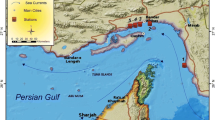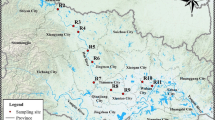Abstract
Microplastics (<5 mm) were extracted from sediment cores collected in Japan, Thailand, Malaysia, and South Africa by density separation after hydrogen peroxide treatment to remove biofilms were and identified using FTIR. Carbonyl and vinyl indices were used to avoid counting biopolymers as plastics. Microplastics composed of variety of polymers, including polyethylene (PE), polypropylene (PP), polystyrene (PS), polyethyleneterphthalates (PET), polyethylene-polypropylene copolymer (PEP), and polyacrylates (PAK), were identified in the sediment. We measured microplastics between 315 µm and 5 mm, most of which were in the range 315 µm–1 mm. The abundance of microplastics in surface sediment varied from 100 pieces/kg-dry sediment in a core collected in the Gulf of Thailand to 1900 pieces/kg-dry sediment in a core collected in a canal in Tokyo Bay. A far higher stock of PE and PP composed microplastics in sediment compared with surface water samples collected in a canal in Tokyo Bay suggests that sediment is an important sink for microplastics. In dated sediment cores from Japan, microplastic pollution started in 1950s, and their abundance increased markedly toward the surface layer (i.e., 2000s). In all sediment cores from Japan, Thailand, Malaysia, and South Africa, the abundance of microplastics increased toward the surface, suggesting the global occurrence of and an increase in microplastic pollution over time.







Similar content being viewed by others
References
Andrady AL (2011) Microplastics in the marine environment. Mar Pollut Bull 62:1596–1605. doi:10.1016/j.marpolbul.2011.05.030
Boonyatumanond R, Wattayakorn G, Amano A, Inouchi Y, Takada H (2007) Reconstruction of pollution history of organic contaminants in the upper Gulf of Thailand by using sediment cores: first report from Tropical Asia Core (TACO) project. Mar Pollut Bull 54:554–565
Browne MA, Crump P, Niven SJ, Teuten E, Tonkin A, Galloway T, Thompson R (2011) Accumulation of microplastic on shorelines woldwide: sources and sinks. Environ Sci Technol 45:9175–9179
Chow TJ, Bruland KW, Bertine K, Soutar A, Koide M, Goldberg ED (1973) Lead pollution: records in Southern California coastal sediments. Science 181:551–552. doi:10.1126/science.181.4099.551
Claessens M, Meester SD, Landuyt LV, Clerck KD, Janssen CR (2011) Occurrence and distribution of microplastics in marine sediments along the Belgian coast. Mar Pollut Bull 62:2199–2204. doi:10.1016/j.marpolbul.2011.06.030
Cózar A et al (2014) Plastic debris in the open ocean. Proc Natl Acad Sci 111:10239–10244. doi:10.1073/pnas.1314705111
Crutzen PJ, Stoermer EF (2000) The “Anthropocene”. Glob Change Newslett 41:17–18
Eriksen M et al (2014) Plastic pollution in the world’s oceans: more than 5 trillion plastic pieces weighing over 250,000 tons afloat at sea. PLoS ONE 9:e111913
Goldberg ED, Hodge V, Koide M, Griffin JJ (1976) Metal pollution in Tokyo as recorded in sediments of the Palace Moat. Geochem J 10:165–174
Isobe A, Uchida K, Tokai T, Iwasaki S (2015) East Asian seas: a hot spot of pelagic microplastics. Mar Pollut Bull 101:618–623. doi:10.1016/j.marpolbul.2015.10.042
Isobe A, Uchiyama-Matsumoto K, Uchida K, Tokai T (2016) Microplastics in the Southern Ocean. Mar Pollut Bull. doi:10.1016/j.marpolbul.2016.09.037
Jambeck JR et al (2015) Plastic waste inputs from land into the ocean. Science 347:768–771. doi:10.1126/science.1260352
Law KL, Morét-Ferguson S, Maximenko NA, Proskurowski G, Peacock EE, Hafner J, Reddy CM (2010) Plastic accumulation in the North Atlantic subtropical gyre. Science 329:1185–1188. doi:10.1126/science.1192321
Li J, Yang D, Li L, Jabeen K, Shi H (2015) Microplastics in commercial bivalves from China. Environ Pollut 207:190–195. doi:10.1016/j.envpol.2015.09.018
Lusher AL, McHugh M, Thompson RC (2013) Occurrence of microplastics in the gastrointestinal tract of pelagic and demersal fish from the English Channel. Mar Pollut Bull 67:94–99. doi:10.1016/j.marpolbul.2012.11.028
Morét-Ferguson S, Law KL, Proskurowski G, Murphy EK, Peacock EE, Reddy CM (2010) The size, mass, and composition of plastic debris in the western North Atlantic Ocean. Mar Pollut Bull 60:1873–1878. doi:10.1016/j.marpolbul.2010.07.020
Napper IE, Thompson RC (2016) Release of synthetic microplastic plastic fibres from domestic washing machines: effects of fabric type and washing conditions. Mar Pollut Bull 112:39–45. doi:10.1016/j.marpolbul.2016.09.025
Obbard RW, Sadri S, Wong YQ, Khitun AA, Baker I, Thompson RC (2014) Global warming releases microplastic legacy frozen in Arctic Sea ice. Earth’s Future 2:2014EF000240. doi:10.1002/2014ef000240
Ogata Y et al (2009) International Pellet Watch: global monitoring of persistent organic pollutants (POPs) in coastal Waters. 1. Initial phase data on PCBs, DDTs, and HCHs. Mar Pollut Bull 58:1437–1446. doi:10.1016/j.marpolbul.2009.06.014
Rothstein SI (1973) Plastic particle pollution of the surface of the Atlantic Ocean: evidence from a seabird. Condor 75:5
Sanada Y, Sato F, Kumata H, Takada H, Yamamoto A, Kato Y, Ueno T (1999) Estimation of sedimentation processes in Tokyo Bay using radionuclides and anthropogenic molecular markers. Geochemistry (Chikyu-kagaku) 33:123–138
Satoto R, Subowo WS, Yusiasih R, Takane Y, Watanabe Y, Hatakeyama T (1997) Weathering of high-density polyethylene in different latitudes. Polym Degrad Stab 56:275–279
Simura K (1985) Aquatic environment of Tokyo-port: water quality and bottom sediment quality of Tokyo-port’s canals. In: 13th Symposium for environmental problem, 1985. Japan Society of Civil Engineers, pp 14–19
Smol JP (2002) Pollution of Lakes and Rivers: a paleoenvironmental perspective. Arnold, London
Takada H, Yamashita R (2016) Chapter 7.2: Pollution status of persistent organic pollutants. United Nations Environment Programme, Nairobi
Tanaka K, Takada H (2016) Microplastic fragments and microbeads in digestive tracts of planktivorous fish from urban coastal waters. Sci Rep 6:34351
Teuten EL et al (2009) Transport and release of chemicals from plastics to the environment and to wildlife. Philos Trans R Soc B Biol Sci 364:2027–2045. doi:10.1098/rstb.2008.0284
The Japan Plastics Industry Federation (2008) History of plastics in Japan (in Japanese). http://www.jpif.gr.jp/p100year/conts/p_history0707.pdf
Van Cauwenberghe L, Vanreusel A, Mees J, Janssen CR (2013) Microplastic pollution in deep-sea sediments. Environ Pollut 182:495–499. doi:10.1016/j.envpol.2013.08.013
Van Metre PC, Mahler BJ (2005) Trends in hydrophobic organic contaminants in urban and reference lake sediments across the United States, 1970–2001. Environ Sci Technol 39:5567–5574. doi:10.1021/es0503175
Vianello A, Boldrin A, Guerriero P, Moschino V, Rella R, Sturaro A, Da Ros L (2013) Microplastic particles in sediments of Lagoon of Venice, Italy: first observations on occurrence, spatial patterns and identification. Estuar Coastal Shelf Sci 130:54–61. doi:10.1016/j.ecss.2013.03.022
Waters CN et al (2016) The Anthropocene is functionally and stratigraphically distinct from the Holocene. Science. doi:10.1126/science.aad2622
Wright SL, Thompson RC, Galloway TS (2013) The physical impacts of microplastics on marine organisms: a review. Environ Pollut 178:483–492. doi:10.1016/j.envpol.2013.02.031
Zettler ER, Mincer TJ, Amaral-Zettler LA (2013) Life in the Plastisphere: microbial communities on plastic marine debris. Environ Sci Technol 47:7137–7146. doi:10.1021/es401288x
Zhao S, Danley M, Ward JE, Li D, Mincer TJ (2017) An approach for extraction, characterization and quantitation of microplastic in natural marine snow using Raman microscopy. Anal Methods. doi:10.1039/C6AY02302A
Acknowledgements
Dr. Masao Takayanagi is thanked for valuable discussions on the IR spectrum of polymers. The authors appreciate Dr. Kosuke Tanaka for providing photos of microplastics. Several students and staff from our laboratories provided assistance in the field. This study was financially supported by a Grant-in-Aid (Project Nos. 26550038, 22254001) and the Environment Research and Technology Development Fund (Project No. 4-1502).
Author information
Authors and Affiliations
Corresponding author
Electronic supplementary material
Below is the link to the electronic supplementary material.
Rights and permissions
About this article
Cite this article
Matsuguma, Y., Takada, H., Kumata, H. et al. Microplastics in Sediment Cores from Asia and Africa as Indicators of Temporal Trends in Plastic Pollution. Arch Environ Contam Toxicol 73, 230–239 (2017). https://doi.org/10.1007/s00244-017-0414-9
Received:
Accepted:
Published:
Issue Date:
DOI: https://doi.org/10.1007/s00244-017-0414-9




